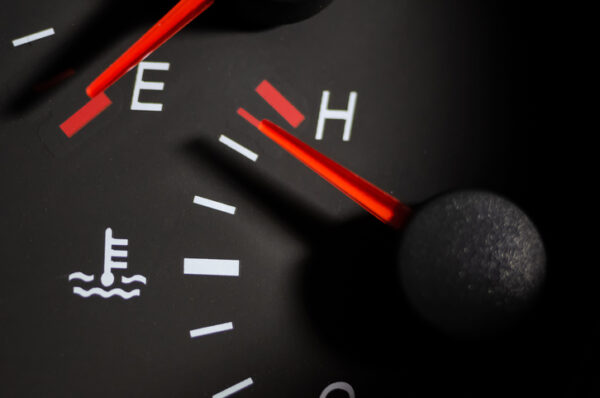How To Add Coolant To Your Air Conditioner
Today's cars accept sophisticated cooling systems equipped with multiple heat sensors and computer-controlled electrical fans designed to keep your engine running in any weather. But overheating can nonetheless happen. Proceed reading on to learn the all-time means to foreclose an overheated machine and steps you lot can take in the event that your car begins to run hot.
Why do engines overheat and how tin can I avoid it?
 Engines overheat for many reasons. By and large, cars overheat considering of a problem with the cooling system that doesn't allow heat to leave the engine compartment. This is often due to a leak or blockage somewhere in the engine cooling system or other components. Other sources may be from a faulty or broken water pump or radiator fan, or from a clogged coolant hose.
Engines overheat for many reasons. By and large, cars overheat considering of a problem with the cooling system that doesn't allow heat to leave the engine compartment. This is often due to a leak or blockage somewhere in the engine cooling system or other components. Other sources may be from a faulty or broken water pump or radiator fan, or from a clogged coolant hose.
Components similar rubber hoses, gaskets, and h2o pumps can spring a leak with regular habiliment and tear, says Richard Reina, product preparation director of CARiD.com, an online auto parts seller. He adds that certain driving conditions, like cease-and-go traffic on a hot day, tin can put significant stress on the cooling system, causing it to fail. Fortunately, you can normally avoid this problem with regular maintenance by a certified mechanic, who will check your car's coolant and oil levels and audit hoses, fans, the thermostat, and other parts in the cooling organisation, Reina says.
But what do you practice if your temperature gauge starts to climb toward "H" or the dashboard warning lite flashes? "The steps yous accept could mean the difference betwixt replacing a $20 thermostat and thousands of dollars in repairs," says Reina.
What are signs of an eastwardngine overheating?
While every vehicle and situation can be unique, there are a few common signs to exist aware of when your car engine is first to overheat:
- Steam (often looking like fume) coming from the front end of the vehicle nether the hood.
- The engine temperature gauge in the dashboard or driver console spiking to "H" or moving into the ruby-red area of the gauge.
- Strange smells or odors emanating from the front of the car, particularly nigh the hood. Leaking coolant can frequently take a sweetness smell, while oil leaks will typically produce a burnt odour.
Here is a list of items to have on hand in the vehicle if your car engine overheats:
- Minor, basic tool kit
- Several quarts of oil
- 1 gallon of coolant (50/50 mix of antifreeze fluid and water)
- Towel
- Heavy-duty gloves

five steps to take when you accept an engine overheating:
1. Plough on the heater.
It sounds counterintuitive, but Reina recommends turning on the heater. It draws warmth away from the engine and into the passenger compartment, lessening the burden on the engine's cooling arrangement. In certain circumstances, that may be enough to reverse the overheating, he says. You'll know information technology's working if the alert light goes off or the temperature gauge returns to the neutral position.
 2. Pull over.
2. Pull over.
If your car continues to overheat afterward you've been driving for a few minutes with the heater on, pull over and cut the engine off—it's the safest and surest way to absurd the engine, says Reina. If yous have roadside help, now is a good fourth dimension to call, as you may need a tow, Reina suggests.
3. Sit tight.
If you don't accept roadside assistance, be patient; it will take at to the lowest degree xv minutes for the engine to absurd. In the concurrently, practice not effort to open the hood; the coolant in a car that has overheated may exist in excess of 230 degrees, says Reina. Once the hood is open, there's a risk of being sprayed with hot water or steam. "Your personal safety is well-nigh important," he says. "Waiting for at least 15 minutes allows the hood, engine and leaking coolant to cool."
iv. Add together coolant.
When you've waited at least 15 minutes and the hood is cool to the touch, put on gloves, open up the hood, and locate the radiator cap (consult the owner'due south manual if necessary), says Reina. Embrace the cap with a towel and slowly push downwards and loosen information technology a quarter of a plow, to release force per unit area that has built up as a result of the coolant expanding when heated. Then fully open up the radiator cap and slowly add coolant—half water, half antifreeze—until the liquid reaches the "full" line. You should too add coolant to the small, articulate plastic overflow reservoir mounted to the side of the radiator, he says. Next, replace the cap and turn on the engine. "If the temperature judge comes dorsum to normal or the red warning lite goes out, y'all tin can continue with caution while keeping an eye on the temperature gauge or light," says Reina.
five. Drive to a service station.
Adding coolant does goose egg to address the problem that caused your engine to overheat in the beginning place, only information technology frequently allows you to drive safely to the nearest repair station. "A professional person will demand to audit your car'southward cooling system," says Reina. While driving, go along an eye on the temperature gauge. And have discover of everything, similar fluid under the car or steam under the hood. "This basic information will greatly help in the diagnosis," Reina explains.
Download and print this PDF checklist of what to do—and what items to have on hand—in case of overheating.
Demand help on the road? Easily asking roadside assistance with the GEICO Mobile app .
By Patrick Rogers
How To Add Coolant To Your Air Conditioner,
Source: https://www.geico.com/living/driving/auto/auto-care/overheating/
Posted by: rossoffied.blogspot.com


0 Response to "How To Add Coolant To Your Air Conditioner"
Post a Comment